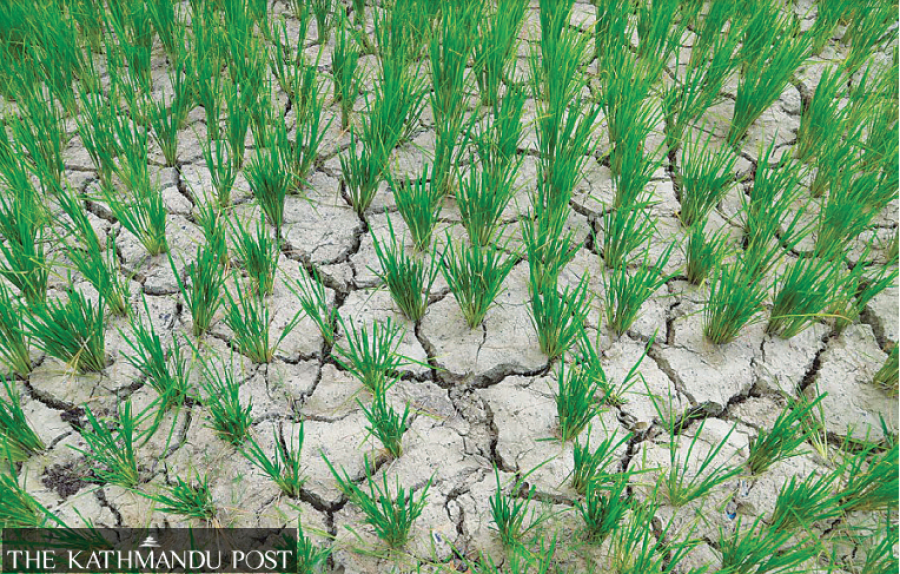
Nepal needs to take mitigation and adaptation strategies to minimise the cost of climate change on the economy amid possibility of high economic losses due to extreme weather events, experts said on Monday.
The World Bank said in its ‘Country Climate and Development Report’ in September that Nepal's gross domestic product (GDP) is estimated to be reduced by seven percent in 2050 solely due to climate change.
According to the global lender, climate change is visibly impacting Nepal with the country being ranked the 10th most affected country in the world, according to the Climate Risk Index.
Considering the effect of rising temperatures on crop yields, the GDP is projected to shrink by between 0.7 percent and 0.8 percent through 2030 across warming scenarios, the World Bank said in its Nepal Development Update Report released in early October. Likewise, the country is likely to see severe damages to infrastructure due to rising incidents of flooding caused by the warming climate, according to the report.
With no additional warming, there is the probability of floods destroying 2.6 percent of infrastructure in the return period of 50 years of capital invested to build infrastructure.
As temperature continues to rise, the probability grows to 5.7 percent with 1.5 degree celsius of additional warming and 18.4 percent with 3.2 degree celsius of additional warming during the return period of 50 years.
At an interaction on the Nepal Development Update organised by the World Bank on Monday, experts said that Nepal not only needed to contribute to reduce carbon emissions but the adaptation process should also move forward simultaneously.
As part of the adaptation process, Nepal needs to invest in climate resilient infrastructure despite additional costs involved in doing so, they said, adding that development partners and the private sector could help generate more resources.
Govinda Nepal, an economist, said that there is no alternative to opting for climate resilient infrastructure despite the fact that Asian Development Bank research estimated the additional cost would rise by 15-20 percent in developing such infrastructure.
“We can adopt the blending finance model to mobilise private resources in developing such infrastructure,” Nepal said. A blending finance is a financing model under which strategic use of public and philanthropic resources are made to mobilise private capital for development purposes. “We can give interest subsidies to private investors and their financing can be used as equity capital,” Nepal added.
Lately, Nepal’s donors have also been focussing on climate resilient infrastructure development. For example, Nepal and the World Bank signed a concessional financing agreement of $100 million in August to support Nepal’s move towards a green, climate-resilient, and inclusive development. This is the first in a programmatic series of three concessional loans on Green, Resilient, and Inclusive Development (GRID), according to the World Bank.
Heidi Tavakoli, deputy development director and head of sustainable growth for Foreign, Commonwealth and Development Office of the United Kingdom in Nepal, also said that her office was supporting Nepal to build all weather roads. “We are also working with Investment Board Nepal to attract foreign investments in climate resilient infrastructure,” she said.
Besides increasing investment in climate resilient infrastructure, experts also pointed out the greater need of promoting the use of clean energy amid continuous high consumption of biomass to fulfil the energy needs of the people.
Biomass, particularly wood burning, is still the largest source of energy in the country. “Nepal needs to promote the use of improved cooking stoves to reduce the pollution caused by wood burning,” said Mani Nepal, programme coordinator at South Asian Network for Development and Environmental Economics (SANDEE) under the International Centre for Integrated Mountain Development (ICIMOD). “With less than three percent of the households using hydropower to meet their energy needs, promotion of electric cooking alone won’t solve the problem of carbon emission.”
The government has adopted the policy of promoting electric ovens and electric vehicles. Nepal, the economist, said that electric cooking could be an alternative to the increasing use of Liquified Petroleum Gas in the country’s urban areas.












